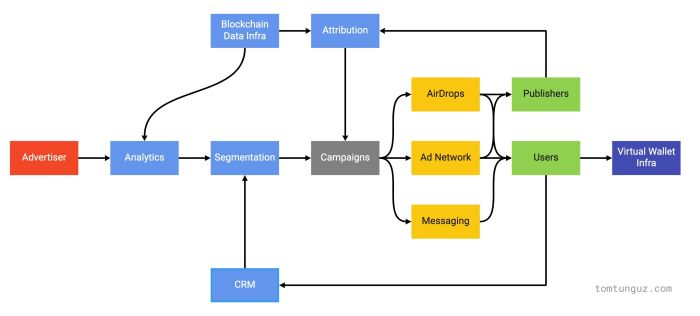For web3 startups to thrive, their marketing teams will need to spend marketing dollars to acquire users efficiently. Existing marketing technology won’t work for web3.
Web2 marketing employs the cookie as the primary identifier of a person, not a wallet. There’s no bridge between web2 & web3 data, yet. The behavioral patterns in web3 differ driven by anonymity, communication patterns on discord and telegram, and the consequences of using tokens as user acquisition, as governance votes, and currency.
There’s an entire marketing ecosystem for startups to build - and it will explode as all the venture dollars web3 startups have raised rushes to find new users.
This is my mental model for it today. Click to enlarge the image.

On the left web3 app marketers (advertisers) gather analytics on their users.
Web3 Analytics resemble web2 in theory but differ in practice. Of course, daily active users and cohort metrics will hydrate dashboards. But so will Discord user activity and token trades. Marketers must answer new questions: Are the people chatting in my Discord tokenholders? Who are the whales (the largest account holders)? How does my user base map to other projects’ user bases? Which users are trading my tokens; how active are they; where are they trading them?
The Analytics systems power Segmentation software. Once a marketer has understood the customer types, Segmentation software clusters users into different groups, some subset of which will receive Campaigns.
Advertisers wage campaigns through AirDrops into wallets, on Ad Networks, through Messaging, or any other number of channels yet to be built.
Ad Networks educate users about new projects while providing revenue to Publishers, application developers and content publishers. These ad networks’ will use public wallet information to target users. NFTs, governed by smart contracts, reward users for engaging with ads with token drops or other on-chain benefits.
While many may turn up their nose at this idea, ad networks will become essential to the ecosystem’s long-term success, providing both distribution and revenue. Having built some of the previous ad infrastructure at Google AdSense, I hope we can reshape the web3 networks with user experience as a central tenet.
Publishers running ads ensure they receive their fees through Attribution software. Attribution will connect ad impressions to on-chain purchases - on-chain data is public, enabling end-to-end cost-per-acquisition (CPA) ads, which maximize the return for Advertisers.
Attribution vendors and Analytics vendors will poll various blockchains constantly to provide up-to-date data. Some will build this in-house, but over time, it will emerge as a separate category.
Advertisers seek to optimize their marketing funnels. Introducing friction during the sign-up process increases the cost-of-customer acquisition. Having driven a user to a web3 app, the advertiser will employ Virtual Wallet Infrastructure.
How does Virtual Wallet Infrastructure work? A user registers with a credential of their choice. Behind the scenes, the app creates a wallet for the user. The user plays a game or uses software in bliss because the developer manages the wallet on their behalf. No 12 word passcode to stymie the conversion funnel. Until the day the user seeks to move their assets, at which point, the user configures a wallet, aligning the point of maximum intent with the greatest friction.
That’s the way I see the web3 marketing stack evolving. If you’re building something in the space, I’d love to hear from you.